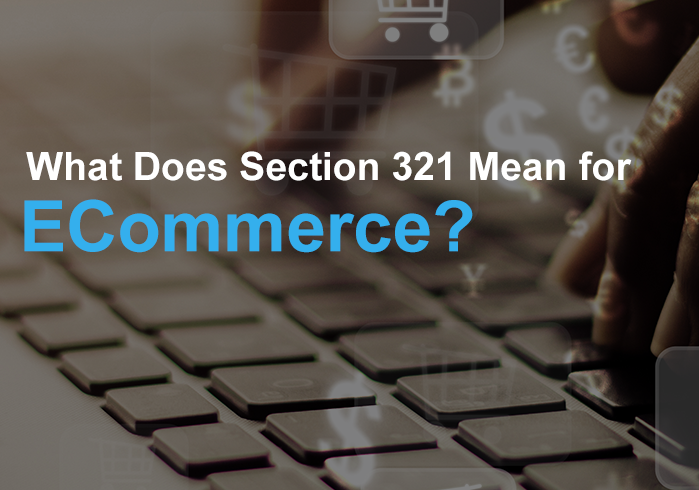
The drive to reduce costs for businesses has made e-Commerce an attractive option, particularly in import-export sectors. The Customs and Border Protection’s (CBP) Section 321 provision makes the achievement of these business goals easier. This provision allows companies to avoid certain duties and taxes on imports.
The target segment is those shipments whose value does not exceed $800. The combination of improved Chinese manufacturing and increased consumer spending in the USA makes this provision expedient. This article explores the key aspects of Section 321 and how they relate to businesses.
What is Section 321 Entry Type 86?
Who is it for?
Section 321 was written as a de minimis shipment provision that allows duty-free importation for low-value packages. It covers freight, land, shipments, and all port entries. This provision references the CBP’s Automated Commerce Environment (ACE) meaning that there is an emphasis on speeding up processes.
Is it required?
Section 321 is useful for all businesses regardless of frequency or total volume of importation, primarily because it accounts for fluctuations in demand. Businesses can easily respond to an e-Commerce boom, no matter how temporary, using this provision. Recent analysis confirms the expectation that Section 321 speeds up the process and cuts overall shipping costs.
In a post-COVID19 era of tight margins and unpredictable markets, Section 321 is a welcome boost for the industry. However, ACE is essential when clearing and hence the need to use freight forwarders. Whereas the provision is optional, many companies have joined the test participant program. It is expected that the requirements will be finessed along the way, although ABI self-filers and customs brokers are directly impacted now.
What are the risks?
No current risks have been identified so far. However, there may be some consequences for non-compliance particularly concerning the one-shipment-per-day provision. Businesses should carefully evaluate this provision in much the same way as you would deal with other imports.
It is important to be organized and accurate in the filing to fulfill all the requirements of Section 321. Otherwise, there may be delays and even penalties in the future. Moreover, the provision does not excuse businesses from existing rules such as compliance with intellectual property protections.
Regulations and moving forward
Businesses should continue monitoring for any updates and conditions. For example, CBP typically requires key information on Section 321 shipments before arrival at the entry port. Some of the modalities may require clarification if uptake of the services continues to grow.
The list of goods and companies that can be put on the program has been growing. For example, CBP included food, cosmetics, and other items in 2019. These were previously handled under the Partner Government Agency (PGA) regulations.
Price and regulations in the U.S.
According to recent reports, CBP is doing more scrutiny on Section 321 entries. For instance, they are checking to ensure maximum value thresholds are not broken. Price estimates and different models are referenced to determine an indicative value.
Some exceptions and exemptions continue to apply to Section 321, most notably tobacco and alcohol. Additionally, all products under the anti-dumping and countervailing duties (AV/CVD) regime are excluded. Similarly, goods requirement inspection or subject to quotas or under a Federal Excise Tax may also be excluded
Shipping limitations
Two key limitations have emerged under Section 321, including the $800 shipment cap and single shipment per day requirement. However, merchandise that is imported through the mail is exempted. No more than one order per day may be subjected to Section 321 provisions, across all carriers or freight forwarders used. Hence, simultaneous application for Section 321 using different entities is forbidden.
China
One of the best aspects of Section 321 is the fact that it effectively overrides section 301 import duties that were imposed during the Trump-era US-China trade war. Meeting the de minimis value means you can avoid those tariffs and taxes. This is a welcome relief for e-Commerce companies that are seeing increased importation of goods from China following the COVID-19 pandemic.
Benefits of Section 321
Cost reduction
The best advantage of Section 321 is that it reduces import costs. Not only can you import duty-free goods, but you may also avoid some of the costs of the US-China trade war. That means that low-cost inputs from China are back in the business mix.
Fewer delays
Moreover, Section 321 reduces the bureaucratic chain and hence time spent on customs. A lot of the documentation can be automated. There is also more sharing of vital information which is critical to reducing delays.
ACE entry prep
Section 321 has had the effect of preparing companies for ACE to complete the eManifest. This is a rapid clearance and processing framework that uses the latest technology. Access includes government agencies, trade companies, CBP, and industry reporting. Because it is a free service, the portal is attractive to the smaller companies that are likely to take advantage of Section 321.
Passing savings on to customers
Once savings are realized through Section 321, these can be passed on to customers in the form of reduced prices for the product. The speed of delivery helps in customer engagement and relationships which will win credibility for businesses. Some businesses may even optimize all their restocking processes so that they are as near to the $800 cap as possible so that they reduce their logistics costs.
Together with 3PL best practices, it is possible to improve order fulfillment and even deal with bulk volumes. Working with a US partner will increase your possibilities of always making deliveries reliably. To realize these benefits, it is advisable to find partners with representatives that are as close as possible to entry and exit ports.
Declaring Section 321
The declaration should confirm compliance with the cap. Where an eManifest is required, CBP must be informed directly that a Section 321 entry is being applied for. You should also indicate the number of goods, country of origin, shipper, and consignee. Customs brokers and freight forwarders are already familiar with the process, hence helping you avoid penalties for multiple applications on a single day.
Best practices
The supply chain must be well-organized to maximize the benefits from Section 321. This includes due diligence and advanced communication. Your partners will expect you to be engaged and visible throughout the process. Additionally:
- Always specify shipments and notify partners in time
- Partners should only make a section 321 request when you ask them to
- All entries should be formalized for auditing and tracking
- Limit the number of brokers and middlemen
- Monitor your communication so that it is received and acted on
Wrapping up
In a post-COVID19 environment when e-commerce is booming, the introduction of Section 321 offers significant benefits for small businesses. Specifically, it allows for duty-free and tax-free importations of small shipments of not more than $800. Each company can only make one Section 321 entry per day, so it is important to have a clear audit process and a strict compliance policy.



One Comment on ““What Does Section 321 Mean for ECommerce?””
After reading this whole article, I got some new information about Section 321. Really this article includes the knowledgeable information. I like your idea to write a blog on this topic. Great job!